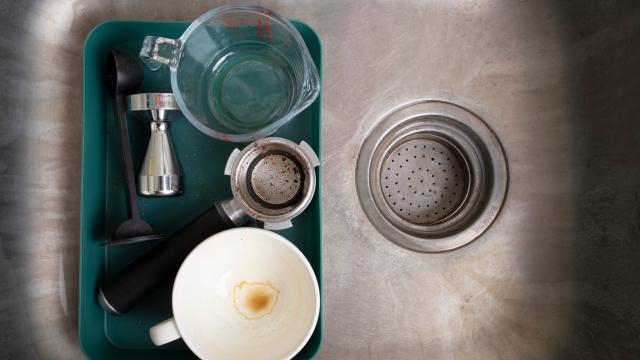Cleaning your coffee maker might be last on your spring cleaning list. After all, the only thing that goes through it are coffee grinds, but hard water deposits and coffee oils can actually affect the mechanics of your machine and change the taste of your coffee.
You should clean your coffee maker at least every three months, but there are things to be aware of, like how using soap can contaminate your coffee and that pod machines use a special tool for cleaning. Here’s how to keep your classic percolator, Keurig, or french press clean and working well.
How to clean your percolator
Rather than use soap (which can turn your drink into dish soap coffee), use vinegar to break down deposits. For percolators, pour equal parts white vinegar and water into the reserve, run the coffee maker like you would a regular pot of coffee (but with no filter), and let the solution sit in the coffee pot for a few minutes before rinsing thoroughly.
You shouldn’t taste the vinegar in your next pot of coffee, but if you’re concerned, fill the reserve with plain water and run the maker through another brew cycle. You should be all set for a fresh pot right after that.
Pod-based coffee makers
Machines that involve inserting a pod to make one or two servings of coffee include Keurig, Nespresso, Senseo, and other brands. Cleaning isn’t quite intuitive though, since the machine just pierces a pod and has hot water siphon through it, but the small piece that pierces the pod can actually get pretty gunked up and needs cleaning.
Clean the coffee needle
Make sure your coffee maker is unplugged before cleaning. Remove the pod pack holder from the machine and press the release buttons to remove the holder from the casing, which is where you’ll find the coffee needle. There should be some lever to press to expose the needle on the other end. Once you get inside, take a paperclip and unfold one end so it sticks out straight, and scrape around the needle to dislodge any coffee grounds clogging up the area.
You can also use a needle cleaning tool if you’re worried about using a paperclip, but the old paperclip lying in your junk drawer is free and works well enough. When you’re done, just rinse out the housing parts and reassemble your coffee maker. You can watch Keurig’s cleaning video for detailed instructions on finding and cleaning their coffee needle.
Descale your coffee maker
You’ll also want to descale your machine — a process for removing hard water buildup and take care of other coffee blockages. Similar to cleaning out a percolator, you’ll need equal parts water and white vinegar.
Fill the water reserve with the solution and run it through without a coffee pod, dumping each cup of water as you continue. (If you have a machine that will not work without a pod inserted, thoroughly clean out a used pod). Turn the device off once the reserve is half empty. For better results, leave the solution overnight. Then, in the morning, turn the machine on to finish up. Do this until the reservoir is empty, pouring out each cup made. Once the reserve is empty, re-run it with only water to rinse out any leftover vinegar residue.
How to clean your French press
To clean out your French press, you’ll need a small brush (it can be a bottle brush or similar tool), a mesh strainer to catch any loosened coffee grounds that may fall into your sink, and baking soda.
First, remove the French press plunger and fill the press with warm water. Swish the water around to flush out any coffee grounds and take your small cleaning brush to scrub the inside of the maker. You can use soap if you like, but make sure to rinse multiple times so you’re not tasting soap in your next cup of coffee.
In addition to (or instead of) soap, sprinkle baking soda and a small amount of water into the press. Use just enough water to scrub the baking soda around and get into the small corners, and rinse. Rinse the plunger and scrub with a cloth to remove any stuck coffee grounds (again, soap isn’t required), wipe it all down with a cloth, and you’re all set for your next brew.

Leave a Reply
You must be logged in to post a comment.